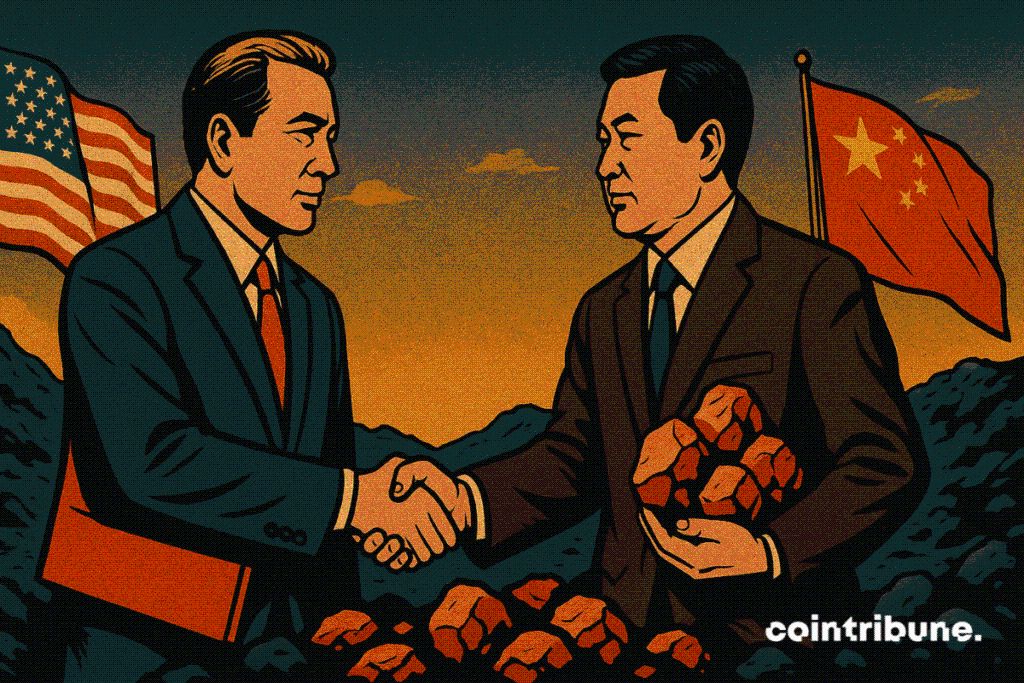Trade Tensions Ease As US And China Strike Mining Deal
A few days before Thanksgiving, Washington and Beijing are preparing to conclude a decisive agreement on rare earths, these vital materials for the technology industry, defense, and crypto mining. In a tense geopolitical climate, this compromise could defuse a crisis with heavy consequences for global supply chains. Faced with the threat of US customs sanctions and Chinese export restrictions, this agreement marks a strategic turning point, but nothing is decided yet.

In brief
- A strategic agreement between the United States and China on rare earths could be signed before Thanksgiving.
- Treasury Secretary Scott Bessent states that China will honor its commitments made during the Trump-Xi summit.
- Washington renounces a 100 % tariff increase, while Beijing suspends its export restrictions.
- This agreement aims to secure access to critical materials for tech, defense, and the crypto mining sector.
Washington and Beijing defuse the rare earth crisis
During his appearance on the Sunday Morning Futures show on Fox News, US Treasury Secretary Scott Bessent announced that an agreement on rare earths between the United States and China, following recent restrictions , could be finalized by Thanksgiving.
“I am confident that after our meeting in Korea between the two leaders, President Trump and Xi, China will honor its commitments”, he stated , referring to recent bilateral negotiations.
According to Bessent, this draft agreement follows a framework established last month between the two powers, in which Washington committed to suspending the imposition of a 100 % tariff on Chinese imports, while Beijing froze the implementation of an export licensing system targeting rare earths and industrial magnets.
The stakes are considerable, especially for strategic American industries that depend on these critical materials, including the crypto mining sector. Rare earths are used in the manufacture of specialized components, essential for the proper functioning of intensive computing machines.
By avoiding a commercial escalation, this agreement temporarily preserves US access to these resources, crucial for maintaining industrial competitiveness. Here are the elements of the agreement :
- The suspension by the United States of a planned tariff increase on imports from China (100 % on certain product categories) ;
- The freezing by China of a proposed export licensing system on rare earths, which would have limited global supply of strategic elements ;
- Beijing’s implicit commitment not to use rare earths as a pressure tool in military or technological sectors, despite certain rumors described as “false” by Scott Bessent ;
- The stated objective is to guarantee the stability of supply chains for sensitive sectors such as defense, technology, and crypto hardware.
This is an attempt at de-escalation, at least temporarily, between the world’s two largest economic powers. It takes place in an still fragile commercial climate, where every diplomatic gesture can have concrete repercussions on markets and industries.
Tensions over agricultural purchases
While the mining part of the agreement seems on track, other promises from the Trump-Xi meeting in South Korea are already eroding, particularly on the agricultural front.
On November 15, the US Department of Agriculture revealed that only two purchases of American soybeans by China had been recorded since the summit, totaling 332,000 tons. A figure far from the 12 million tons that Agriculture Secretary Brooke Rollins had mentioned for the period ending in January, and well below the 25 million tons per year promised for the next three years.
“We are still very far from what the United States announced in terms of agreement”, commented Tanner Ehmke, chief economist at CoBank, noting that China has never officially confirmed such quantitative promises.
China, according to Ehmke, has large stocks of soybeans from Brazil and other South American countries. Moreover, US exports continue to be penalized by a 24 % tariff, even after a ten-point reduction, making American products less competitive.
Furthermore, Beijing has only stated that there is consensus to expand trade in agricultural products, without quantified commitments or precise timelines. While Trump assured on Sunday that “China will buy a lot of soybeans,” markets remained skeptical, and prices dropped by 23 cents to reach $11.24 a bushel after the USDA report was released.
This gap between political speeches and the reality of trade casts a shadow over the true scope of the Sino-American agreement. While the rare earth part seems to be moving toward stabilization, agriculture reveals a more uncertain dynamic, illustrating the limits of this diplomatic rapprochement. For actors in the crypto sector, these mixed signals urge caution.
The ongoing agreement may only represent a partial ceasefire in a trade war with deep ramifications. While critical supply chains seem temporarily secured, future developments will depend as much on Beijing’s strategic decisions as on the strength of US commitments.
Disclaimer: The content of this article solely reflects the author's opinion and does not represent the platform in any capacity. This article is not intended to serve as a reference for making investment decisions.
You may also like
Powell faces the ultimate test: At least three dissenters at the December meeting, Federal Reserve consensus collapses!
The "Fed mouthpiece" reported that internal divisions within the Federal Reserve have intensified amid a data vacuum, with three board members appointed by Trump strongly supporting a dovish stance, while the hawkish camp has recently expanded.
Weekly Hot Picks: Data Disappearance Doesn’t Stop the Fed’s Hawkish Stance! Global Multi-Asset Markets Face “Backstabbing”
The U.S. government shutdown has ended, but the release of key data remains chaotic. The Federal Reserve has sent frequent hawkish signals, causing significant declines in gold, silver, stocks, and currencies on Friday. The U.S. has launched Operation "Southern Spear". Buffett delivered his farewell letter, and the "Big Short" exited abruptly. What exciting market events did you miss this week?


SignalPlus Macro Analysis Special Edition: Is It Going to Zero?
Over the past week, cryptocurrency prices declined once again. BTC briefly reached $94,000 on Monday due to lighter selling pressure before pulling back, and major cryptocurrencies saw further week-on-week declines...

